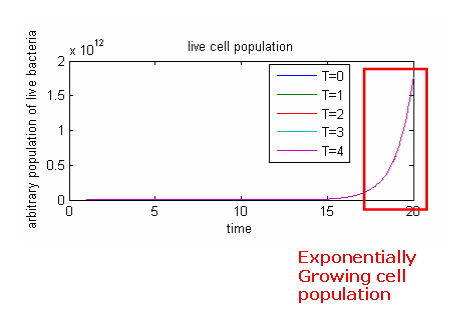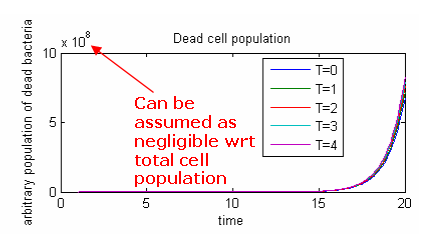Team:Imperial College London/Drylab/Genome Deletion/Simulations
From 2009.igem.org
(Difference between revisions)
| Line 29: | Line 29: | ||
[[Image:m3s.4.png | left]] | [[Image:m3s.4.png | left]] | ||
| - | [[Image:m3s.5.png | + | [[Image:m3s.5.png ]] |
*We can tell from the above simulation that when the temperature is low, cell growth will be exponential as there is negligible cell death. | *We can tell from the above simulation that when the temperature is low, cell growth will be exponential as there is negligible cell death. | ||
Revision as of 14:25, 22 September 2009

Simulation 1: Effects of increased temperatures on cell population
Effects on DpnII and TaqI production with regards to increasing temperatures
- The killing term is set to be greater than the growth term in our parameters. This is to ensure there is cell death when temperatures are above threshold.
- We can see that there is an increased concentration of restriction enzymes being produced at higher temperatures.
- This agrees with our hypothesis that high temperatures de-repress the lambda cI promoter and result in the production of restriction enzymes DpnII and TaqI.
- At the pre-steady stage, there is an initial spike in production of mRNA and restriction enzymes, hence the small “bump”. This results from the delay in production of protein cI, which eventually brings down the concentration of mRNA and restriction enzymes to steady state.
Temperature below threshold – Exponential Increase in cell population
- We can tell from the above simulation that when the temperature is low, cell growth will be exponential as there is negligible cell death.
Note that we have an exponentially increasing dead cell population. However, this can be considered negligible, as the number of dead cells is of magnitudes smaller than total cell population.
Temperature above threshold – Cell population goes to zero
- In the simulation, when we increase the temperature, ie, by increasing varying the arbitrary temperatures, cells start to die after an initial exponential cell growth. Hence temperatures indeed will induce cell death.
- Furthermore, we notice that an increase in temperature will cause the “bump”to shift left and down. This shows that increasing temperatures increases rate of killing.
- Furthermore, the above simulation shows a “bump”in live cell population.
- Initially, there is an exponential increase in live cell population because restriction enzymes take time to be produced, hence cell growth outnumbers cell death. Cell growth is greater at a lower temperatures as well, as restriction enzymes are produced at a slower rate.
- At the height of the “bump”cell growth is balanced by cell death.
- The decrease in live cell population afterwards shows the time when cell death is greater than cell growth, due to the killing by restriction enzyme, and total cell population starts to decline. This is when M3 has fully kicked in.
- Note that at the threshold temperature, cell death balances cell reproduction, and we would notice a straight line in the live cell curve. Above this temperature, cell death dominates.
- For the dead cell population, at higher temperatures, we see less dead cells. This is because killing starts early, and there will be less cells produced, and thus, less cells to kill.
- We also note that when all E. coli have been killed, dead cell population seem to saturate.
N.B. Note that the values we have used for temperature are arbitrary, and they are for the purpose of illustrating the behaviour of the system. In reality, this will be linked to our data, and the parameters will change.
 "
"








